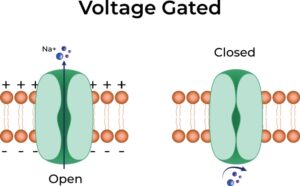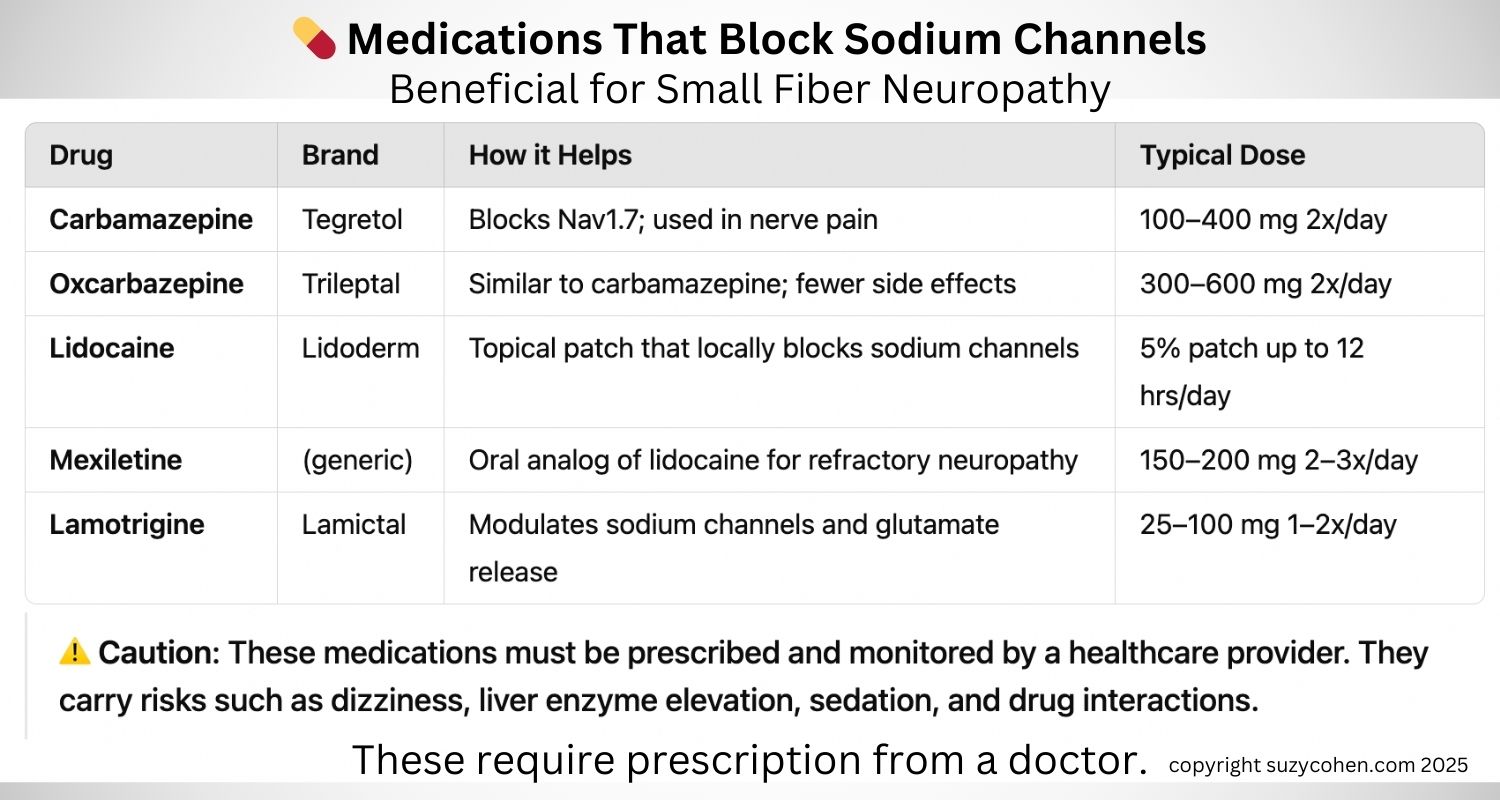What's On This Page?
ToggleIf you’re struggling with burning pain, tingling, or strange nerve symptoms, you may already know about Small Fiber Neuropathy (SFN) – a condition affecting the tiny unmyelinated nerves responsible for pain, temperature, and autonomic functions. What you may not know is that mutations or dysfunction in certain sodium channels (like these which you can click on and look up later SCN9A, SCN10A, SCN11A) can cause these nerves to fire uncontrollably, like a broken smoke alarm beeping nonstop!
This hyperexcitability of nerves is a big deal, and some conventional medications calm it down by blocking the sodium channels. But did you know there are natural compounds that may do this too? I’ll tell you about those in just a moment. And be sure to scroll to the end—I’ve included a free downloadable PDF with a curated list of sodium channel blockers you’ll want to check out.
Quick note: There aren’t any formal clinical studies (yet) on the specific items I’m about to list. No one’s had the time—or funding—to tackle that. So, I rolled up my sleeves and did the digging myself… for all of us.
In this article, I’ll share 5 of the best natural sodium channel blockers—plus a bonus one I just couldn’t leave out. Think of these as your “nerve soothers.” I’ll also highlight 5 pharmaceutical options I recommend from my experience as a pharmacist who’s been on the frontlines of integrative care for decades—I know what tends to work. One important note: If you have diabetes, keep in mind that some degree of small fiber neuropathy is a known complication, even if your blood sugar is well-managed.
I write about thyroid illness all the time since I recovered from that, and wrote a book about it. I want you to know that SFN can sometimes occur in people with hypothyroidism. When your thyroid is underactive, your metabolism slows down, which affects everything including your nerves. Over time, low thyroid hormone levels (left untreated) will impair nerve function and even damage the small nerve fibers responsible for pain, temperature, and autonomic functions (like digestion and heart rate). This can lead to those classic SFN symptoms: burning, tingling, numbness, or even weird sensations like crawling or electric shocks. You can read more about hypothyroidism in THIS ARTICLE: 4 Ways to Differentiate Between Hashimoto’s and Hypothyroidism.
Also, sign up for my Thyroid Thursday free newsletter HERE.

Also, autoimmune thyroid disorders like Hashimoto’s thyroiditis can increase the risk. Why? Because autoimmune diseases tend to travel in packs—so someone with Hashimoto’s might also be dealing with autoimmune-related neuropathy. Inflammation and immune dysregulation can directly damage nerves.
If you’re feeling those symptoms and have a thyroid condition, it’s worth looking deeper.
This illustration here is of a “Voltage Gated Sodium Channel” and it shows you how sodium channels open to let sodium ions (Na⁺) flow into your nerve cells, triggering the transmission of pain signals.
In SFN, these channels can become overactive, causing nerves to misfire.
Top 10 Symptoms of Small Fiber Neuropathy (SFN)
Small Fiber Neuropathy affects the small sensory cutaneous nerves, often leading to pain and autonomic dysfunction. The symptoms are typically symmetrical and begin in the feet or hands.
-
Burning pain – Common in feet and hands, often worse at night.
-
Tingling (paresthesia) – Pins-and-needles sensation in affected areas.
-
Numbness – Gradual loss of sensation, typically in extremities.
-
Electric shock-like pain – Sudden, sharp jolts of nerve pain.
-
Allodynia – Pain from stimuli that shouldn’t be painful (e.g., light touch).
-
Muscle cramps or twitching – Due to nerve hyperexcitability.
-
Altered temperature perception – Impaired ability to sense hot or cold.
-
Dry eyes or mouth – Caused by autonomic nerve involvement.
-
Gastrointestinal symptoms – Bloating, nausea, constipation.
-
Cardiovascular irregularities – Heart rate changes or arrhythmias.
Both natural compounds and prescription medications known as sodium channel blockers help by stabilizing these channels—preventing excessive sodium influx and reducing abnormal nerve signaling at the cellular membrane.

Why Sodium Channels Matter in SFN
Sodium channels are like electrical gates in your nerve cells. When they open and close properly, your nerves send normal signals. But when they’re damaged or genetically altered—like in SFN—they may stay open too long or fire too frequently, causing burning, stabbing pain, or autonomic chaos. Blocking or modulating these channels can help quiet those signals and relieve pain.
The 5 Best Natural Sodium Channel Blockers
The following natural compounds act as sodium channel blockers (also known as sodium channel inhibitors in scientific literature), to help calm nerve hyperactivity in people who have Small Fiber Neuropathy.
-
Alpha Lipoic Acid (ALA)
- How it works: ALA reduces oxidative stress and stabilizes nerve cell membranes, indirectly calming sodium channel overactivity.
- Suggested dose: 600 mg once or twice daily (R-form is preferred for better absorption). There are integrative clinics around the U.S. that offer this in intravenous form.
- Caution: This supplement can lower blood sugar so watch closely if you take insulin or other diabetic meds. It enhances the effect.

-
Capsaicin (from chili peppers)
- How it works: Temporarily overstimulates pain nerves, then causes them to desensitize, reducing nerve firing. May affect sodium and TRPV1 channels. Interestingly, capsaicin is one of the primary ingredient in cayenne pepper, and if you’ve ever cut your finger, my next article will fascinate you: Cayenne Pepper Stopped My Bleeding in 30 Seconds.
- Suggested use: Topical cream (0.025%–0.1%) or 8% prescription patch for more severe cases.
- Caution: Expect initial burning or irritation. Avoid mucous membranes and wash your hands well. I’ve written about this compound numerous times over the years so use my search box to find other relevant articles.

-
Cannabidiol (CBD from Cannabis)
- How it works: Modulates multiple ion channels (including Nav1.7) and reduces inflammatory cytokines.
- Suggested dose: Start low at 10–25 mg and titrate up based on response.
- Caution: Can interact with certain meds (CYP450 pathway). Look for full-spectrum, third-party-tested brands.
-
Omega-3 Fatty Acids (EPA/DHA)
- How it works: Supports nerve membrane health and reduces sodium influx. Anti-inflammatory. And you thought it was just good for your cholesterol!
- Suggested dose: 1,000–3,000 mg daily (combined EPA/DHA).
- Caution: May thin blood at higher doses so consult your doctor if on anticoagulants and start with low doses.

-
Theaflavins (from black tea)
- How it works: Theaflavins may be a new word to some of you. Theaflavins are made when green tea leaves are turned into black tea. During that process (called fermentation) some natural plant chemicals in the green tea (called catechins) change into new compounds. One of those new compounds is “theaflavin” which gives black tea its dark color and flavor. They have antioxidant, anti-inflammatory, and even sodium/calcium channel–modulating potential. Antioxidant polyphenols that may help regulate sodium and calcium channels.
- Suggested dose: 300–500 mg standardized extract daily or 2 – 3 cups of strong black tea.
- Caution: Contains caffeine unless decaffeinated. Caffeine can interfere with iron absorption and I want you to read this article on iron deficiency anemia so you’ll know if you’re getting too much of a good thing: Could Iron Deficiency Anemia Be Draining You? 8 Critical Tests to Know.
🌱 Bonus: Curcumin (from Turmeric) – It’s not a Sodium Channel Blocker But… It Helps!
- How it works: Curcumin is best known for its powerful anti-inflammatory effects. It inhibits pro-inflammatory cytokines like TNF-α and IL-6, which may indirectly help calm sodium channel sensitivity. While NOT a direct sodium channel blocker, it is thought to reduce nerve excitability and oxidative stress, supporting overall nerve health. This could be helpful for some people, not all. It’s worth honorable mention here as far as I’m concerned because people with SFN need as many options as possible.
- Suggested dose: 500–1,000 mg daily of curcumin extract, preferably in a form enhanced with black pepper (piperine) or liposomal delivery for better absorption. I put a patented form of C3® curcumin in my Joint Script® supplement for flexibility and cytokines. If you have stiffness or joint pain, consider it – it is one of my #1 sellers. CLICK HERE to learn more.
- Caution: Can thin blood slightly at high doses. Avoid before surgery or if taking anticoagulants unless advised by your physician. May also affect gallbladder function—use with caution if you have gallstones or bile duct issues.

✨ Final Thoughts
If you’re dealing with SFN, you know how frustrating it can be to chase symptoms that seem invisible. The good news? We now understand much more about sodium channel mutations and nerve overactivity, and there are both natural and pharmaceutical options to help dial down the noise.
Whether you’re looking for plant-based solutions or need clinical-strength support, there’s a path forward. And as always – check with your physician or pharmacist (👋 hi there!) before starting anything new.
If you have any nerve pain or neuropathy, I am developing a topical spray that can soothe your nerves. It is in development now, so subscribe to our emails at the bottom of this website if you’d like to be put on the list to be notified when my formula is released. It will be later in 2025.
👉 CLICK HERE to download my one-page handout of sodium channel blockers — both natural and prescription—to bring to your healthcare provider.

Suzy Cohen, has been a licensed pharmacist for over 30 years and believes the best approach to chronic illness is a combination of natural medicine and conventional. She founded her own dietary supplement company specializing in custom-formulas, some of which have patents. With a special focus on functional medicine, thyroid health and drug nutrient depletion, Suzy is the author of several related books including Thyroid Healthy, Drug Muggers, Diabetes Without Drugs, and a nationally syndicated column.


